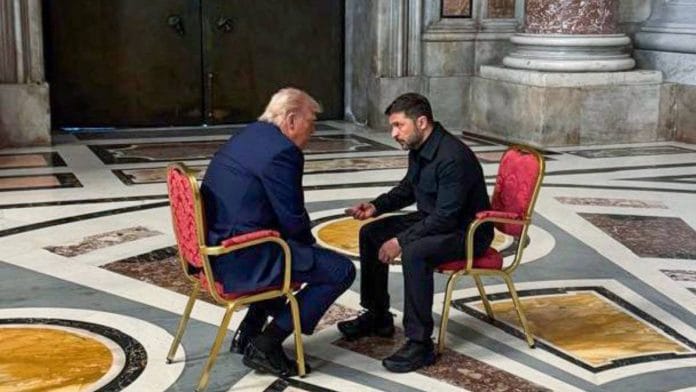New Delhi: The US and Ukraine finally signed a critical minerals deal Wednesday, after months of back and forth between the two administrations. The deal includes creation of a joint reconstruction investment fund, giving the US a stake in the future of Ukraine.
The two countries have engaged in difficult negotiations since Donald Trump assumed the US presidency this January.
First proposed by Ukrainian President Volodymyr Zelenskyy in September last year at a meeting with Trump before the US polls, the deal comes as the American president continues to apply pressure on Kyiv in his efforts to broker a peace deal with Russia.
“It will be funded by contributions from the US and Ukraine. The fund’s profits will be reinvested exclusively in Ukraine. Thanks to this agreement, we will be able to attract significant resources for reconstruction, start economic growth and receive the latest technologies from partners and a strategic investor in the person of the United States,” Denys Shmyhal, Prime Minister of Ukraine, said in a post on the messenger application Telegram.
He added that “the fund is being created on a 50/50 basis and both parties have equal voting rights”, with Ukraine retaining full control over the “subsoil, infrastructure and natural resources”.
Negotiations for the deal were at times fraught, with the original signing, slated at the end of February, being cancelled following a tense Oval Office exchange between Zelenskyy and Trump. Both the US President and Vice President J.D. Vance chastised Zelenskyy in front of the global media.
The two berated Zelenskyy for being “ungrateful” to the US, and Trump in particular, and said Ukraine should work harder for a ceasefire deal with Russia. The signing of the minerals deal and a televised press conference was cancelled, with the Ukrainian President leaving Washington for London.
The administration under Trump has pushed hard for a ceasefire between Kyiv and Moscow, after Trump, while on the campaign trail last year, promised to end the Russia-Ukraine war within 24 hours of assuming power.
However, despite both Zelenskyy and Russian President Vladimir Putin agreeing to a ceasefire during phone conversations with Trump, the promises have not translated into any serious effort on the frontlines. This has led to Trump consistently blaming his predecessor Joe Biden for the war that began in February 2022 when Russia announced a “special military operation” in Ukraine.
Last month, after negotiations between US officials and Russian and Ukrainian delegations, Secretary of State Marco Rubio indicated that Washington may abandon peace efforts if there was no progress towards a final ceasefire.
US Secretary of Defence Pete Hegseth also said that any return to pre-2014 boundaries for Ukraine was an “illusionary” objective, while the US administration has made it clear that it would be unwilling to provide any security guarantees for an eventual peace deal. Washington has instead called on its European allies to underwrite any peace deal.
Also Read: India’s ‘influence’ with Russia crucial in ensuring long & just peace, says Ukraine foreign minister
What’s the critical minerals deal?
In the middle of April, the US and Ukraine signed a memorandum of understanding (MoU) to “finalise” an economic partnership and reconstruction fund agreement, highlighting the basic framework of the critical minerals deal.
“The Government of the United States and the Government of Ukraine enter into this Memorandum of Intent to work expeditiously towards the completion of the necessary documents in order to finalise the agreement forging an economic partnership between the American and Ukrainian peoples and establishing a reconstruction investment fund,” the MoU on the website of the Ukrainian government states.
The final agreement, as described by Shmyhal in his Telegram post, has nothing to do with repayment of debt but focusses on “new investments” that will fund “projects and guarantee commercial purchases of products on a ‘take or pay’ basis”.
It would allow US firms access to the Ukrainian market and its resources, especially in a potential scenario where Kyiv and Moscow arrive at a ceasefire agreement.
Some of the early versions of the deal were heavily favoured towards American access to Ukrainian resources, while Kyiv’s early negotiations focussed on including a security guarantee from the US.
However, in the current version, a joint investment fund would be created, which would reinvest profits into reconstruction of Ukraine.
For Ukraine, the deal is the first step in larger security guarantees, as Zelenskyy said in March. For Kyiv, any potential deal with Russia has three red lines: no compromise on its territorial integrity, no limits to its military capacity and no third country veto on its future alliances.
(Edited by Nida Fatima Siddiqui)
Also Read: Europe is vital for lasting solution in Ukraine. Trump’s Nobel obsession is blocking this






